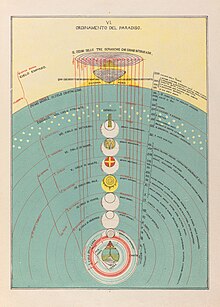
| Part of a series on |
| Thelema |
|---|
 |
| The Rights of Man |
The body of light, sometimes called the 'astral body'[a] or the 'subtle body,'[b] is a "quasi material"[1] aspect of the human body, being neither solely physical nor solely spiritual, posited by a number of philosophers, and elaborated on according to various esoteric, occult, and mystical teachings. Other terms used for this body include body of glory,[2] spirit-body, luciform body, augoeides ('radiant body'), astroeides ('starry or sidereal body'), and celestial body.[3]
The concept derives from the philosophy of Plato: the word 'astral' means 'of the stars'; thus the astral plane consists of the Seven Heavens of the classical planets. The idea is rooted in common worldwide religious accounts of the afterlife[4] in which the soul's journey or "ascent" is described in such terms as "an ecstatic, mystical or out-of body experience, wherein the spiritual traveller leaves the physical body and travels in their body of light into 'higher' realms."[5]
Neoplatonists Porphyry and Proclus elaborated on Plato's description of the starry nature of the human psyche. Throughout the Renaissance, philosophers and alchemists, healers including Paracelsus and his students, and natural scientists such as John Dee, continued to discuss the nature of the astral world intermediate between earth and the divine. The concept of the astral body or body of light was adopted by 19th-century ceremonial magician Éliphas Lévi, Florence Farr and the magicians of the Hermetic Order of the Golden Dawn, including Aleister Crowley.
Cite error: There are <ref group=lower-alpha> tags or {{efn}} templates on this page, but the references will not show without a {{reflist|group=lower-alpha}} template or {{notelist}} template (see the help page).
- ^ Samuel & Johnston (2013).
- ^ Behun (2010).
- ^ Mead (1919), pp. 34–35.
- ^ Miller (1995), p. [page needed].
- ^ Woolger (n.d.).
